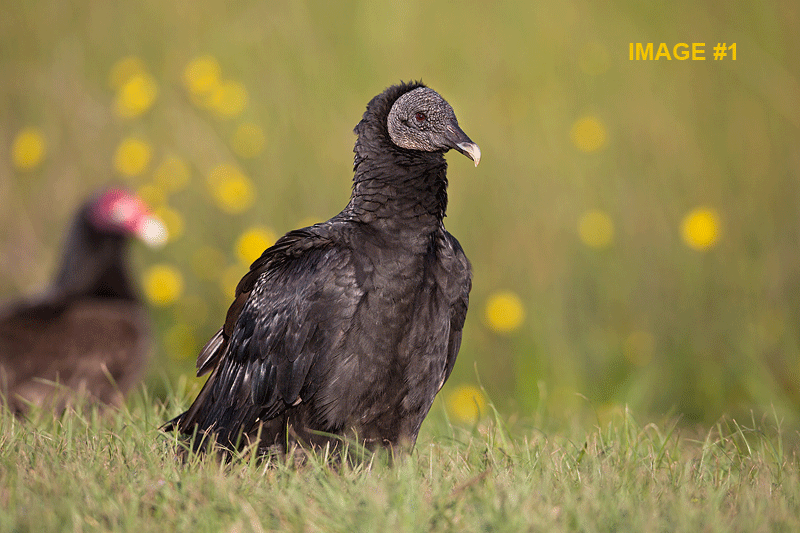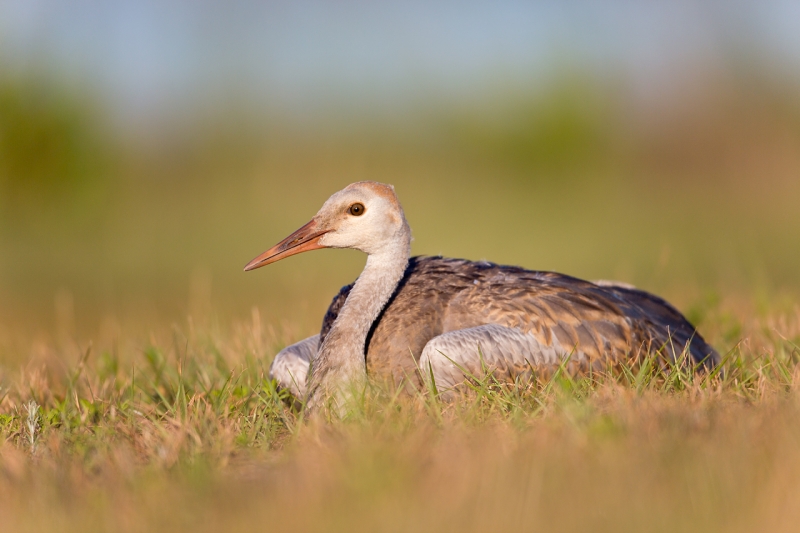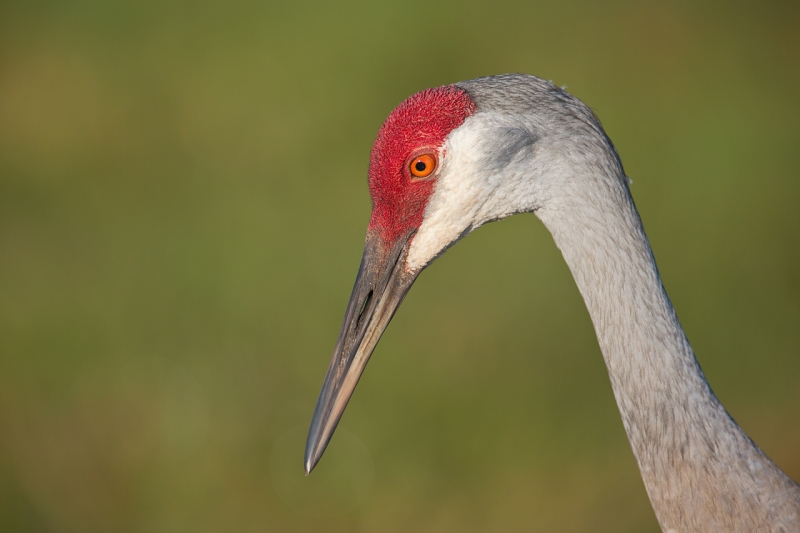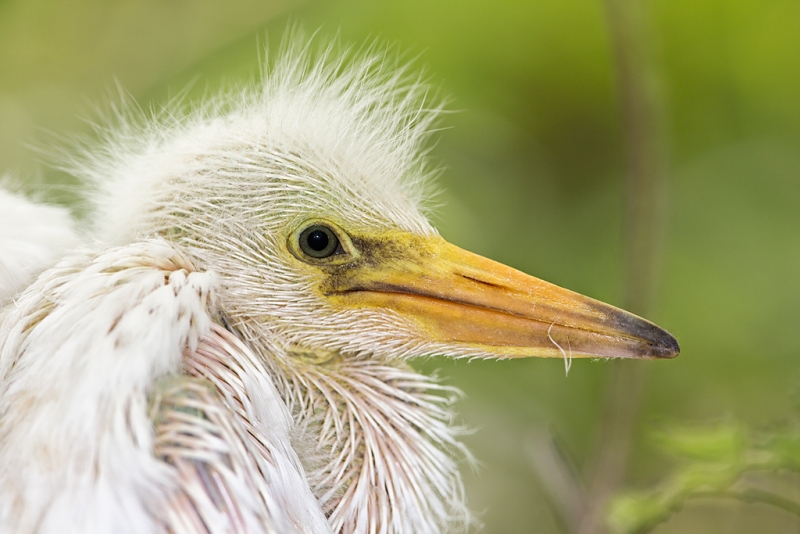Stuff: Catching Up
|
Sandhill Crane, colt lying on grass, Indian Lake Estates, FL. With the Canon 800mm f/5.L IS lens and the Canon EOS-5D Mark III supported by a BLUBB on ground. ISO 400. Evaluative metering +1/3 stop: 1/1250 sec. at f/5.6 in Manual mode–early morning light at 7:45 am. |
Lying Down on the Job
In Lying Down on the Job, my favorite of the first three photographs was image #2 above.
Why? The intimate perspective, the sharpness, the fact that the light appeared sweeter than in Image #1 even though that image was made a few minutes earlier, and mostly because of the halo of out-of-focus vegetation in the foreground and background that envelop the subject. In addition I love the strip of blue sky at the top. Note that I positioned the bird’s head to fall between the two large out-of-focus green bushes just above the bird in the distant background. That was not an accident. Lastly, the tiny silver stalk in the lower left corner of the frame balances the composition nicely with the gray tones of the young crane.
I do find the small out-of-place feather on the back of the colt’s head (in the image above) to be somewhat distracting and should have removed it.
|
Sandhill Crane, adult head portrait, Indian Lake Estates, FL. With the the hand held Canon 300mm f/2.8 L IS II lens, the 1.4X III TC, and the Canon EOS-5D Mark III. ISO 400. Evaluative metering +-1/3 stop: 1/3200 sec. at f/4 in Manual mode at 7:57am. |
I love the head portrait too for it’s sharpness, the lovely green background, and the out-of-the-ordinary pose. For me my overall favorite of the four would be #2 over #4 by a small margin as I have been trying for years for something like #2. Lots of folks were on the same page as me choosing #2 and #4 as their faves.
You can read my responses to the many comments on the crane images by scrolling down here.

|
Juxtapositions in Black
In Juxtapositions in Black most folks preferred the second image but there was some late support for the first image. I agreed with either no one or everyone as I feel that both images are examples of successful juxtaposition-type images. When I saw the Turkey Vulture walking behind the Black Vulture I knew that there might be an opportunity for a juxtaposition type image. When it stopped just to the left of the Black Vulture, I created Image 1. Then the TV continued to walk to my right (its left). I should have made an image when the TV was almost directly behind the BV. It would have been a good example of a bad image. As the TV continued to pass the BV I created Image 2.
In Image 1 you might imagine that the BV is the more dominant bird with the Black Vulture standing tall and upright and looking large and the Turkey Vulture behind it and looking small and rather insignificant. In Image 2 the BV’s posture might be construed as a submissive one and the TV might be seen as the dominant bird. Unlike many of the folks who commented, I do like both compositions. And yes Juan Carlos, I love the o-o-f yellow flowers in each image.
|
This head portrait of a Snowy Egret chick was created with the tripod-mounted Canon 300mm f/2.8 L IS II lens, the 2X III teleconverter, and the Canon EOS-5D Mark III. ISO 400. Evaluative metering +1/3 stop: 1/80 sec. at f/8 in Av mode. Fill flash at -1 stop with my brand new Canon Speedlite 600EX-RT and a Better Beamer. Good news there: the FX-3 fits the Canon Speedlite 600EX-RT perfectly. For a greater appreciation of this image, click on the photo. |
Why Stop There?
In Why Stop There? several folks who responded hit the nail on the head as to why I left the single feather strand. Hats off to Dennis Zaebst who was the first one to offer a pretty much perfect answer: Nice Shot Artie. I think you left the single feather so the juvenile bird would appear as natural as possible, while the rest of the cleanup was done to avoid distraction from the main subject. The single remaining feather does not detract, and allows one to see the bird as it was at the time. My buddy Charles Scheffold said the same thing in different words: The feather adds interest whereas the other stuff just makes it look like a dirty bill. I like it. The only thing that I would add is that though I do lots of clean-up, recently I have been striving too avoid too perfect….
Folks who use a Better Beamer with their telephoto lenses will want to read my comments on when and why to remove the Beamer’s Fresnel screen. Most folks have no clue. See my comments in green in response to Charles Scheffold’s May 2, 2012 2:26pm comment.
Today’s Question
Does anyone know why Fresnel is capitalized in Fresnel lens or Fresnel screen? Or how to pronounce it? Double points if you did not have to do a Google search. 🙂
MIDWAY 2013 SINGLE OPENING
Due to a cancellation, there is now a single opening on the formerly sold out Midway trip. Click here for details and photos. Call 863-692-0906 or e-mail immediately if you are good to go.
| [Not a valid template] |
|
Painted Bunting, male, Santa Clara Ranch, Starr County, TX This image was created with the tripod-mounted Canon 800mm f/5.L IS lens, the EF 25mm Extension Tube, and the Canon EOS-1D Mark IV. ISO 400. Evaluative metering +1 stop: 1/100 sec. at f/5.6. Fill flash at -3 stops with the 580 EX II Speedlite and a Better Beamer. The extension tube allows for close focus inside the minimum focusing distance of the lens. We got to photograph several male Painted Buntings on my first visit to Santa Clara. When you are working at 1/100 sec. as I was here, it is imperative that the subject not move during the exposure…. |
Cheap, Short-Notice, Practically Private Instruction at the Santa Clara Ranch, near McCook, TX
I am looking for no more than four photographers to join me and two other leaders (one of whom is named Denise Ippolito) at the ground level water hole blinds on the Santa Clara Ranch near McCook, TX. Amazingly, Google Maps has never heard of McCook, TX. But not to worry, it is on Mapquest 🙂 I first visited Beto Gutierrez’s ranch in early May 2010. You can learn more about that visit here or check out the ranch here.
With the three leaders the likely group size will be six–one student per leader, but might–depending on the level of interest–wind up at 8. You would need to be in McAllen, TX on the late afternoon of Monday May 14, 2012. If you are on our flight to McAllen (United 1621) know that we might stop to do some giant sunflower photography on the way to the ranch which is about an hour west of McAllen. There will be morning and afternoon photography sessions on Tuesday & Wednesday, May 15 and 16th and a final shorter session on the morning of Thursday May 17th. The three leaders will be flying out of McAllen on the 1:27 United flight to Houston.
We will have a variety of songbirds coming to the water along with some snakes and possibly a few mammals that will surely include Mexican Ground Squirrel. Bird species will likely include Painted Bunting, Northern Cardinal, Black-crested (Mexican) Titmouse, Bronzed Cowbird, Long-billed Thrasher, Northern Mockingbird, Mourning Dove, and Olive Sparrow. As migration is underway we may very well be in for a surprise or two. Other possibilities include Green Jay, Lark Sparrow, Pyrrhuloxia, Groove-billed Ani, and Audubon’s Oriole among others.
What’s included: lodging in the simple but modern ranch-house which has ac and wi-fi! Blind fees. Image sharing and individual and small group Photoshop lessons. We will share the cost of a shopping trip and all will get to experience some BIRD AS ART home cooking (unless the want to do some cooking themselves). I don’t cook breakfasts. 🙂 Lunches and dinners will be healthy and simple but oh so good.
What’s not included: ground and ranch transportation and the shared cost of the food. We would be glad to try to set you up with a car pool partner.
Recommended gear: a minimum of a 500mm f/4 lens with both teleconverters and an extension tube. A sturdy tripod along with a Mongoose M3.6 or a Wimberley V2 head, your flash, a Better Beamer, and a flash bracket. An intermediate telephoto would be a huge plus if we are lucky enough to have deer, armadillo, opossum, collared peccary, or dare I even say it aloud–a bobcat come in for a drink. There might be some flowers around….
Cheap, Short-Notice Practically Private Instruction at the Santa Clara Ranch, near McCook, TX. May 14-17, 2012. 2 FULL and one half-day (includes lodging and blind fees): $999. Limit: 5/Openings: 4)
To register or to check on availability please call me immediately at 863-692-0906 and e-mail as well. If there is no answer and you wish to leave a message please call 863-692-0906. A non-refundable $500 is required and may be placed by credit card.
Click here to see the original post and several additional images.
Shopper’s Guide
Below is a list of the gear used to create the images above. Thanks a stack to all who have used the Shopper’s Guide links to purchase their gear as a thank you for all the free information that we bring you on the Blog and in the Bulletins. Before you purchase anything be sure to check out the advice in our Shopper’s Guide.
Canon 800mm f/5.6L IS lens. Right now this is my all time favorite super-telephoto lens.
Canon 300mm f/2.8 L IS II lens. The 300 f/2.8 L IS II with the 1.4X III TC is a killer flight combination.
1.4X III TC. The new Series III 1.4X was designed to work best with the new Series II super-telephoto lenses.
2X III teleconverter. The new 2X TC is sharper than the older Series II 2X TC and is designed to work best with the Series II super-telephoto lenses–two out and two more coming sometime in 2012.
Speedlite 600EX-RT. Canon’s latest greatest professional flash has more features than I will ever use or need. Click here and scroll down for lots more info on the new flash.
Canon EOS-5D Mark III. Man, I am in love with this camera body. Both the files and the AF system are superb.
Canon EOS-1D Mark IV professional digital camera body. The very best professional digital camera body that I have ever used.
And from the BAA On-line Store:
BLUBB. I personally designed the Big Lens Ultimate BeanBag and have it made in the good old US of A. This large beanbag is ideal when working with super-telephoto lenses from your vehicle. Beware of cheaper and much inferior copycat rip-offs; you get what you pay for just like your Daddy said.
LensCoats. I have a LensCoat on each of my big lenses to protect them from nicks and thus increase their re-sales value. All my big lens LensCoat stuff is in Hardwood Snow pattern.
Double Bubble Level. You will find one in my camera’s hot shoe whenever I am not using flash.
The Lens Align Mark II. I use the Lens Align Mark II pretty much religiously to micro-adjust all of my gear an average of once a month and always before a major trip. Enjoy our free comprehensive tutorial here.
BreezeBrowser. I do not see how any digital photographer can exist without this program.

















When do you think your Canon 5D Mark III guide will be completed?
Thank you for your invaluable website.
I started working on it on my flights to Portland on 5/9. It is gonna be a while as it is a lot of work! Thanks for your interest. artie
“Colt”—are the chicks of all cranes called ” colts?”
I believe that that is correct sir.
Ok, I e-mailed you three links to flickr of images that people seem to look at. The pics are when I changed to Canon and just learning. Framing and such not good at all. But fairly sharp pics I think.
Fresnel lens — The “F” is capitalized because it is named for its inventor, Fresnel (don’t remember the first name, didn’t Google it.
For pronunciation the “s” is silent, sounds like “frennel”.
That’s my guess and I’m sticking to it!
Love the juvenile Snowy shot!
Fresnell is the name of a man who created the lens. Pronounced fray-nell
Close but only on “l” in his last name :). fray-NELL with the accent on the second syllable is correct. Additional info: Fresnel: a type of lens originally developed by French physicist Augustin-Jean Fresnel for lighthouses.
I like birds and shoot in Texas when back home. That Painted bunting is a very common bird. When back in Texas I go to the State Parks there. Last time out Lost Maples State park had these guys by the gob’s and only 10 bucks. They feed daily and excellent blind set up. Just thought I would throw that in for some that might not get to go on your trip. Very easy to take and MANY MORE…. Deer, Turkey at Lano state park, daily. And 3 excellent blinds and staff.
Just a thought for some that might want to venture out on there own. No world class instructor though.. 🙁
Do e-mail me three of your best images from the “excellent $10 set-up” joint so that I can share them with the group here. artie
I’ll have to ask her – her dad is Belgian and she grew up bilingual so she’ll probably have it right. I see that according to Wikipedia (I looked it up after answering) that Frezz-Nell is a secondary pronunciation, but after reading about Mr. Fresnel it’s pretty obviously wrong. You can hear the correct pronunciation here.
Thanks for the link. As to the approved mis-pronunciation, it is a shame as far as I am concerned that incorrect usage/spelling/pronunciation with the English language often leads to acceptance… As with farther/further and “wish I was” instead of “wish I were…” Among dozens of others.
I’ve always said Frezz-Nell, but my wife always considers my pronunciation suspect as it blends normal Ohio, Appalachian Ohio, Latin, Spanish German and French more or less randomly.
FREZZ-nell is wrong but that’s how we all say it. How does your wife pronounce it??? I will concentrate on saying it correctly from here on. 🙂
If its capitalized, I assume its named after somebody that developed that type of lens. I’m guessing Mr. Fresnel 🙂
Doug
Good guess. Now how do you say it? Actually, Mr. Fresnel was an interesting guy.